GDP Fluctuations in Canada: Trends, Contributing Factors, and Impacts
VerifiedAdded on 2023/06/03
|8
|1412
|333
Report
AI Summary
This report provides an overview of GDP fluctuations in Canada over the past 10 years, focusing on factors contributing to growth trends. It highlights the historical background of the Canadian economy, emphasizing the role of service and manufacturing industries, as well as natural resources. The report identifies factors causing GDP fluctuations, such as free trade agreements, interest rates, housing prices, employment, currency values, and oil prices. It also discusses factors contributing to growth trends, including openness to trade, investment in human capital, and business investments. Furthermore, the report analyzes the impacts of GDP fluctuations on the nation's economy, including variations in currency values, government policies, and interest rates. The conclusion emphasizes the stability of GDP growth after the recessionary period due to policy interventions by the Canadian government, primarily fueled by consumption and exports.
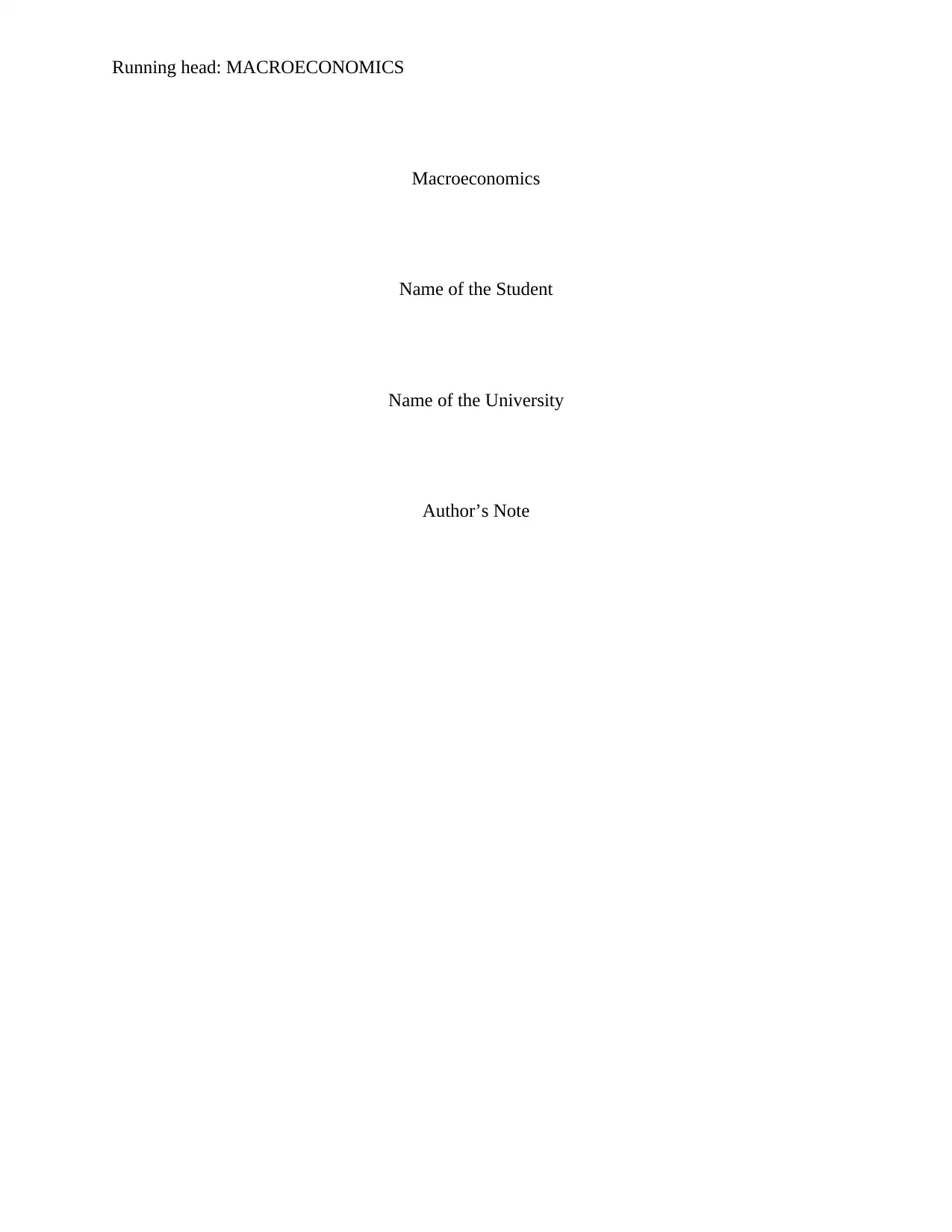
Running head: MACROECONOMICS
Macroeconomics
Name of the Student
Name of the University
Author’s Note
Macroeconomics
Name of the Student
Name of the University
Author’s Note
Paraphrase This Document
Need a fresh take? Get an instant paraphrase of this document with our AI Paraphraser
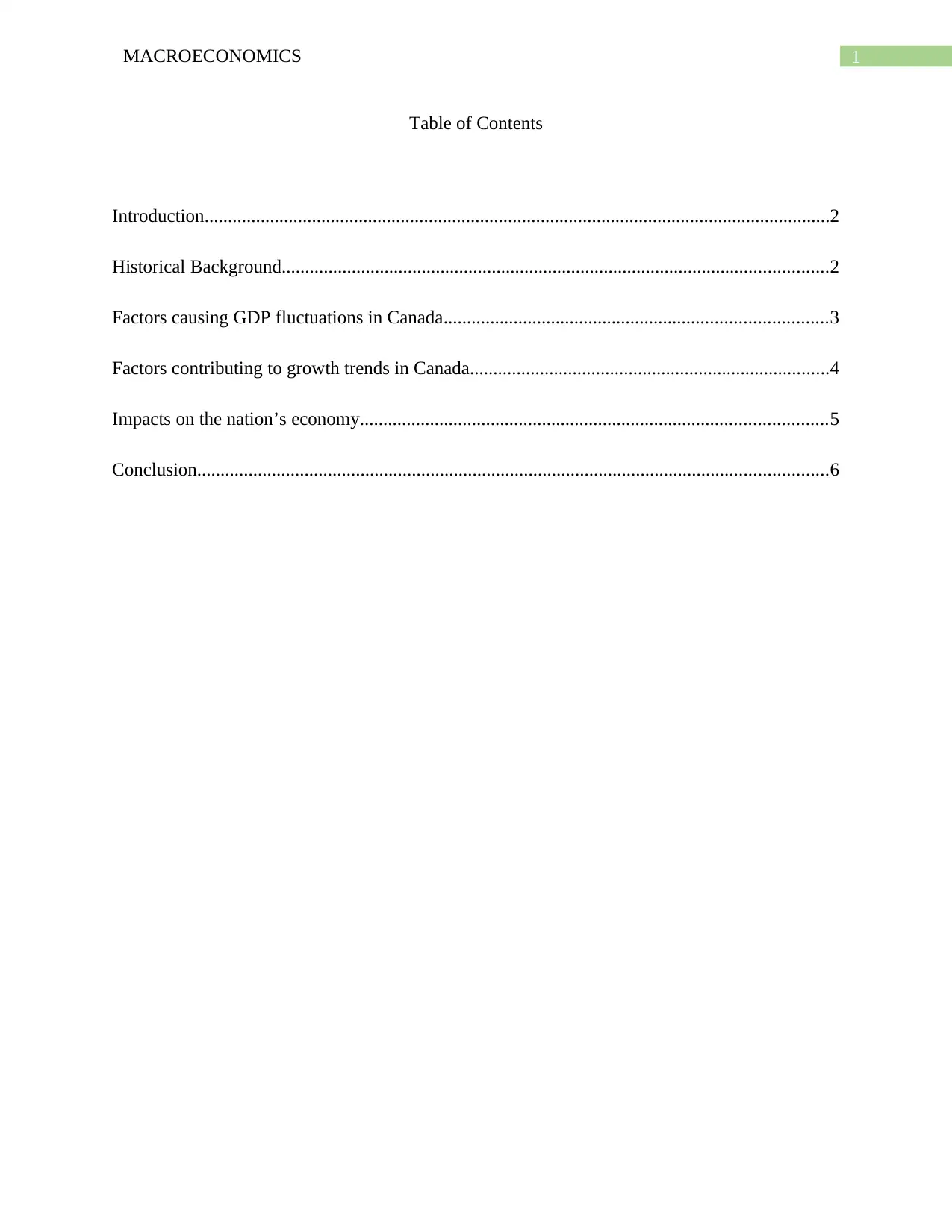
1MACROECONOMICS
Table of Contents
Introduction......................................................................................................................................2
Historical Background.....................................................................................................................2
Factors causing GDP fluctuations in Canada..................................................................................3
Factors contributing to growth trends in Canada.............................................................................4
Impacts on the nation’s economy....................................................................................................5
Conclusion.......................................................................................................................................6
Table of Contents
Introduction......................................................................................................................................2
Historical Background.....................................................................................................................2
Factors causing GDP fluctuations in Canada..................................................................................3
Factors contributing to growth trends in Canada.............................................................................4
Impacts on the nation’s economy....................................................................................................5
Conclusion.......................................................................................................................................6
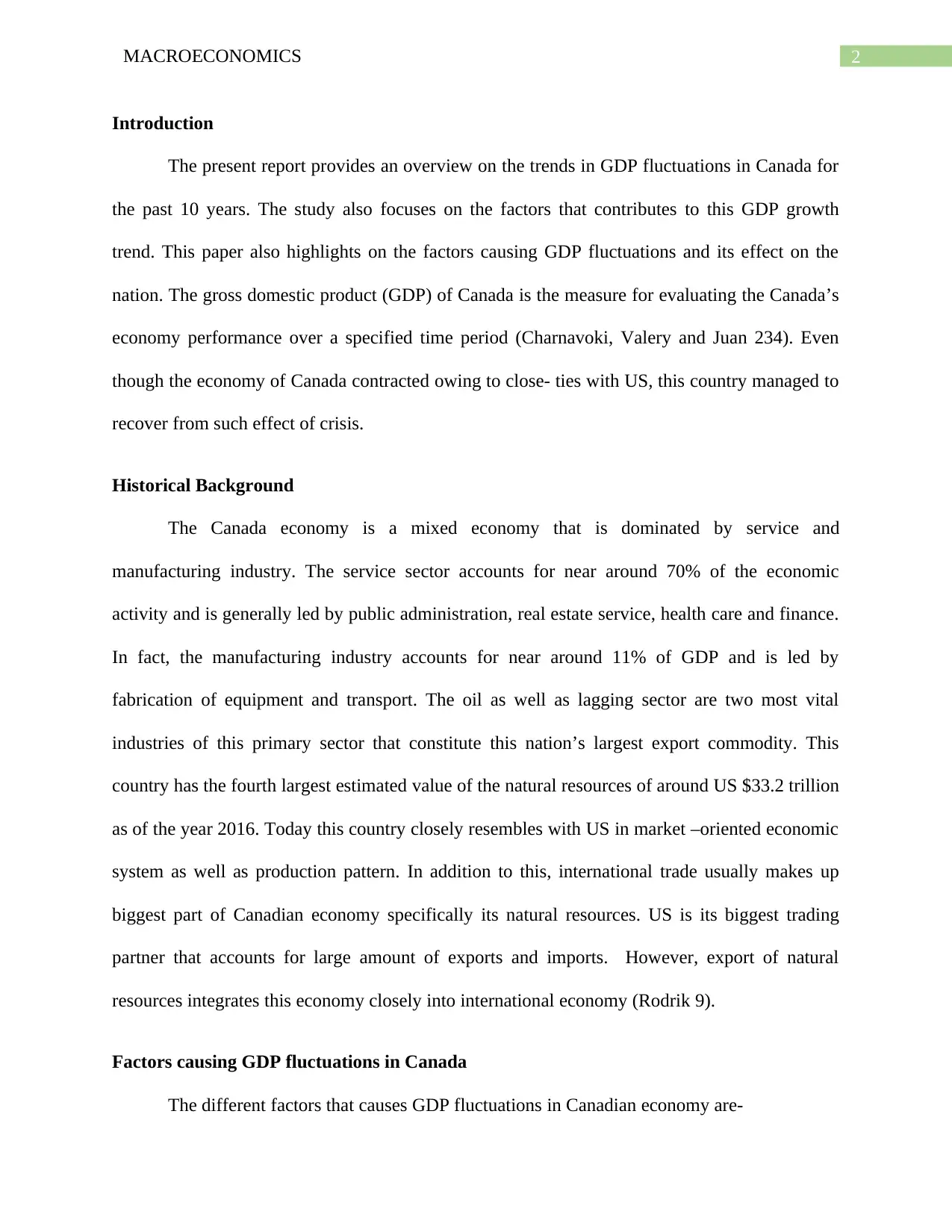
2MACROECONOMICS
Introduction
The present report provides an overview on the trends in GDP fluctuations in Canada for
the past 10 years. The study also focuses on the factors that contributes to this GDP growth
trend. This paper also highlights on the factors causing GDP fluctuations and its effect on the
nation. The gross domestic product (GDP) of Canada is the measure for evaluating the Canada’s
economy performance over a specified time period (Charnavoki, Valery and Juan 234). Even
though the economy of Canada contracted owing to close- ties with US, this country managed to
recover from such effect of crisis.
Historical Background
The Canada economy is a mixed economy that is dominated by service and
manufacturing industry. The service sector accounts for near around 70% of the economic
activity and is generally led by public administration, real estate service, health care and finance.
In fact, the manufacturing industry accounts for near around 11% of GDP and is led by
fabrication of equipment and transport. The oil as well as lagging sector are two most vital
industries of this primary sector that constitute this nation’s largest export commodity. This
country has the fourth largest estimated value of the natural resources of around US $33.2 trillion
as of the year 2016. Today this country closely resembles with US in market –oriented economic
system as well as production pattern. In addition to this, international trade usually makes up
biggest part of Canadian economy specifically its natural resources. US is its biggest trading
partner that accounts for large amount of exports and imports. However, export of natural
resources integrates this economy closely into international economy (Rodrik 9).
Factors causing GDP fluctuations in Canada
The different factors that causes GDP fluctuations in Canadian economy are-
Introduction
The present report provides an overview on the trends in GDP fluctuations in Canada for
the past 10 years. The study also focuses on the factors that contributes to this GDP growth
trend. This paper also highlights on the factors causing GDP fluctuations and its effect on the
nation. The gross domestic product (GDP) of Canada is the measure for evaluating the Canada’s
economy performance over a specified time period (Charnavoki, Valery and Juan 234). Even
though the economy of Canada contracted owing to close- ties with US, this country managed to
recover from such effect of crisis.
Historical Background
The Canada economy is a mixed economy that is dominated by service and
manufacturing industry. The service sector accounts for near around 70% of the economic
activity and is generally led by public administration, real estate service, health care and finance.
In fact, the manufacturing industry accounts for near around 11% of GDP and is led by
fabrication of equipment and transport. The oil as well as lagging sector are two most vital
industries of this primary sector that constitute this nation’s largest export commodity. This
country has the fourth largest estimated value of the natural resources of around US $33.2 trillion
as of the year 2016. Today this country closely resembles with US in market –oriented economic
system as well as production pattern. In addition to this, international trade usually makes up
biggest part of Canadian economy specifically its natural resources. US is its biggest trading
partner that accounts for large amount of exports and imports. However, export of natural
resources integrates this economy closely into international economy (Rodrik 9).
Factors causing GDP fluctuations in Canada
The different factors that causes GDP fluctuations in Canadian economy are-
⊘ This is a preview!⊘
Do you want full access?
Subscribe today to unlock all pages.

Trusted by 1+ million students worldwide
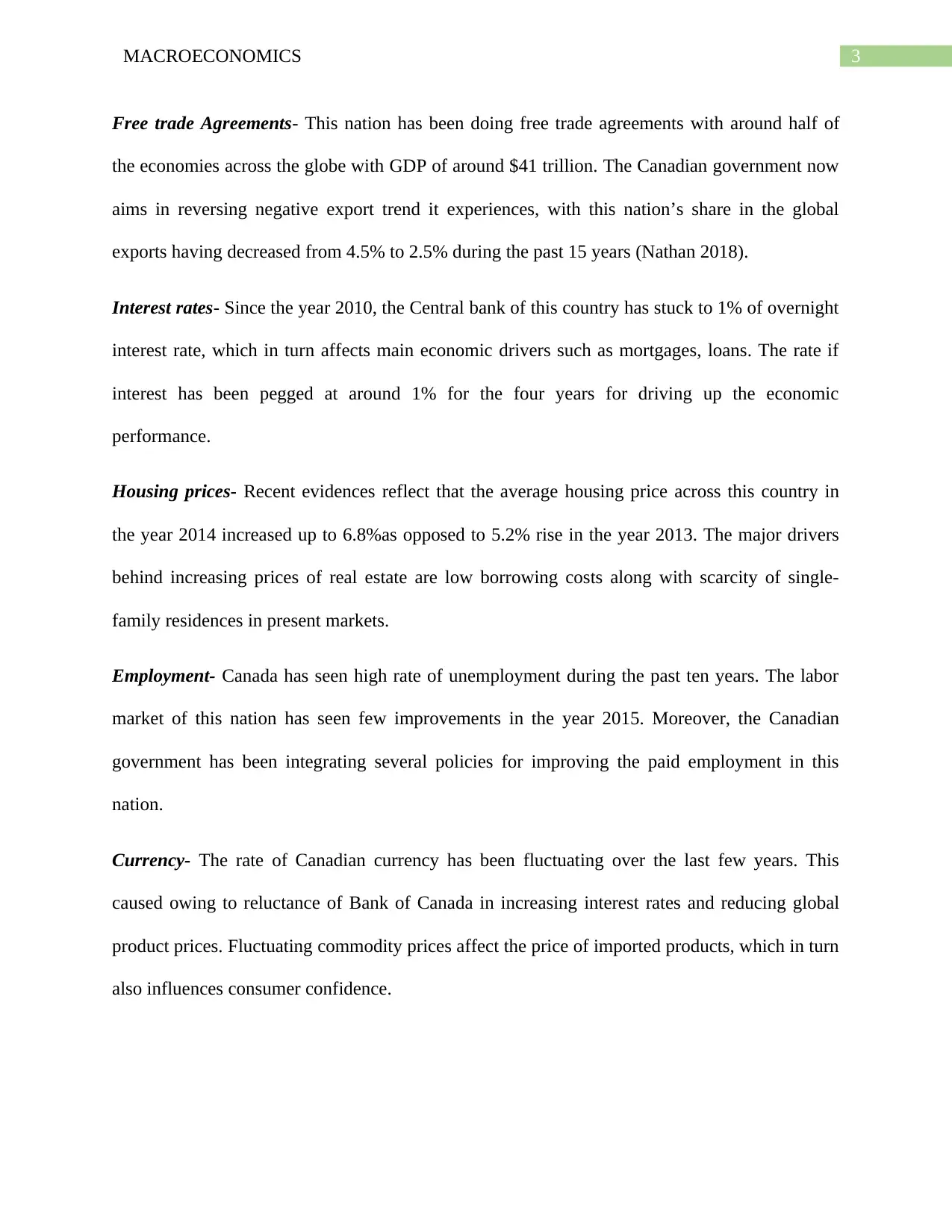
3MACROECONOMICS
Free trade Agreements- This nation has been doing free trade agreements with around half of
the economies across the globe with GDP of around $41 trillion. The Canadian government now
aims in reversing negative export trend it experiences, with this nation’s share in the global
exports having decreased from 4.5% to 2.5% during the past 15 years (Nathan 2018).
Interest rates- Since the year 2010, the Central bank of this country has stuck to 1% of overnight
interest rate, which in turn affects main economic drivers such as mortgages, loans. The rate if
interest has been pegged at around 1% for the four years for driving up the economic
performance.
Housing prices- Recent evidences reflect that the average housing price across this country in
the year 2014 increased up to 6.8%as opposed to 5.2% rise in the year 2013. The major drivers
behind increasing prices of real estate are low borrowing costs along with scarcity of single-
family residences in present markets.
Employment- Canada has seen high rate of unemployment during the past ten years. The labor
market of this nation has seen few improvements in the year 2015. Moreover, the Canadian
government has been integrating several policies for improving the paid employment in this
nation.
Currency- The rate of Canadian currency has been fluctuating over the last few years. This
caused owing to reluctance of Bank of Canada in increasing interest rates and reducing global
product prices. Fluctuating commodity prices affect the price of imported products, which in turn
also influences consumer confidence.
Free trade Agreements- This nation has been doing free trade agreements with around half of
the economies across the globe with GDP of around $41 trillion. The Canadian government now
aims in reversing negative export trend it experiences, with this nation’s share in the global
exports having decreased from 4.5% to 2.5% during the past 15 years (Nathan 2018).
Interest rates- Since the year 2010, the Central bank of this country has stuck to 1% of overnight
interest rate, which in turn affects main economic drivers such as mortgages, loans. The rate if
interest has been pegged at around 1% for the four years for driving up the economic
performance.
Housing prices- Recent evidences reflect that the average housing price across this country in
the year 2014 increased up to 6.8%as opposed to 5.2% rise in the year 2013. The major drivers
behind increasing prices of real estate are low borrowing costs along with scarcity of single-
family residences in present markets.
Employment- Canada has seen high rate of unemployment during the past ten years. The labor
market of this nation has seen few improvements in the year 2015. Moreover, the Canadian
government has been integrating several policies for improving the paid employment in this
nation.
Currency- The rate of Canadian currency has been fluctuating over the last few years. This
caused owing to reluctance of Bank of Canada in increasing interest rates and reducing global
product prices. Fluctuating commodity prices affect the price of imported products, which in turn
also influences consumer confidence.
Paraphrase This Document
Need a fresh take? Get an instant paraphrase of this document with our AI Paraphraser
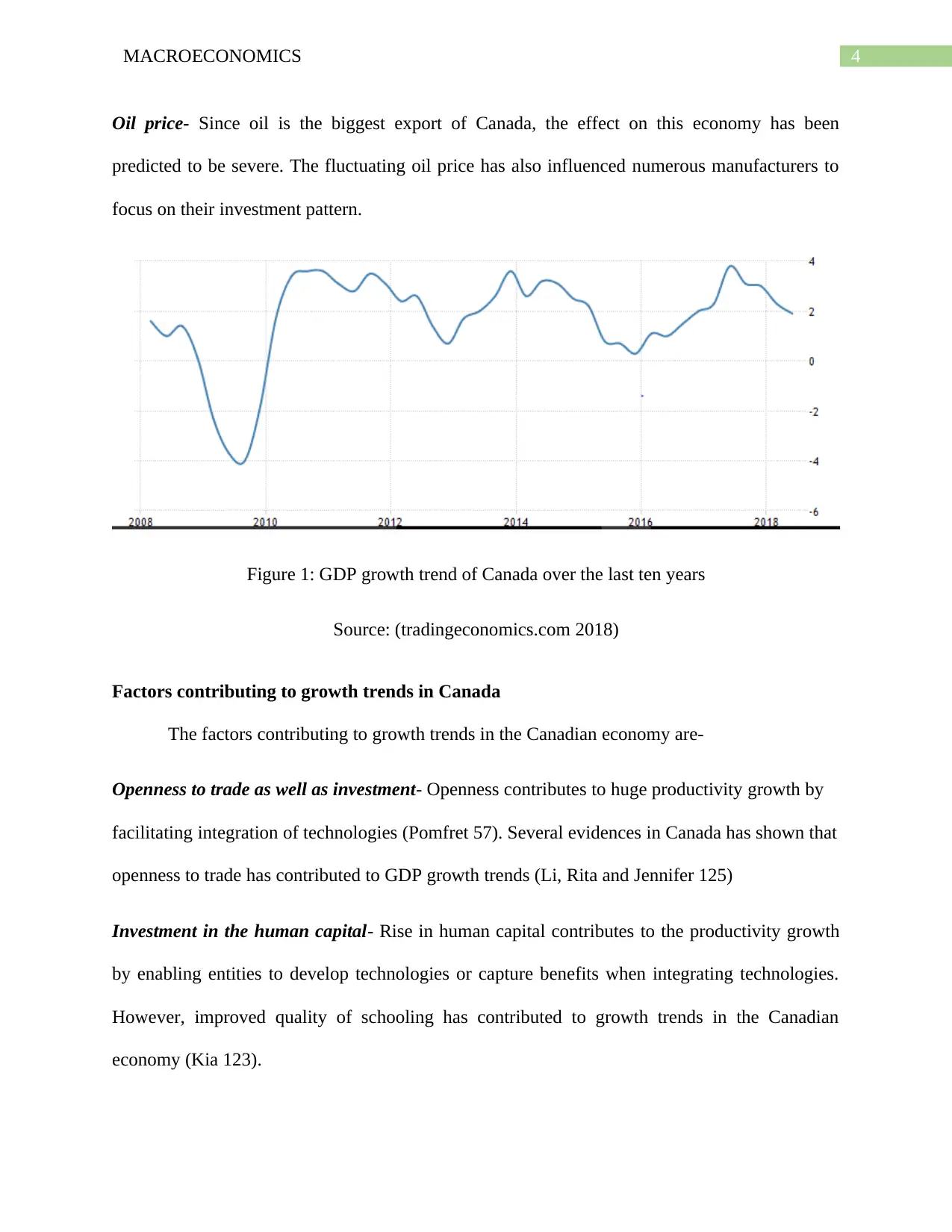
4MACROECONOMICS
Oil price- Since oil is the biggest export of Canada, the effect on this economy has been
predicted to be severe. The fluctuating oil price has also influenced numerous manufacturers to
focus on their investment pattern.
Figure 1: GDP growth trend of Canada over the last ten years
Source: (tradingeconomics.com 2018)
Factors contributing to growth trends in Canada
The factors contributing to growth trends in the Canadian economy are-
Openness to trade as well as investment- Openness contributes to huge productivity growth by
facilitating integration of technologies (Pomfret 57). Several evidences in Canada has shown that
openness to trade has contributed to GDP growth trends (Li, Rita and Jennifer 125)
Investment in the human capital- Rise in human capital contributes to the productivity growth
by enabling entities to develop technologies or capture benefits when integrating technologies.
However, improved quality of schooling has contributed to growth trends in the Canadian
economy (Kia 123).
Oil price- Since oil is the biggest export of Canada, the effect on this economy has been
predicted to be severe. The fluctuating oil price has also influenced numerous manufacturers to
focus on their investment pattern.
Figure 1: GDP growth trend of Canada over the last ten years
Source: (tradingeconomics.com 2018)
Factors contributing to growth trends in Canada
The factors contributing to growth trends in the Canadian economy are-
Openness to trade as well as investment- Openness contributes to huge productivity growth by
facilitating integration of technologies (Pomfret 57). Several evidences in Canada has shown that
openness to trade has contributed to GDP growth trends (Li, Rita and Jennifer 125)
Investment in the human capital- Rise in human capital contributes to the productivity growth
by enabling entities to develop technologies or capture benefits when integrating technologies.
However, improved quality of schooling has contributed to growth trends in the Canadian
economy (Kia 123).
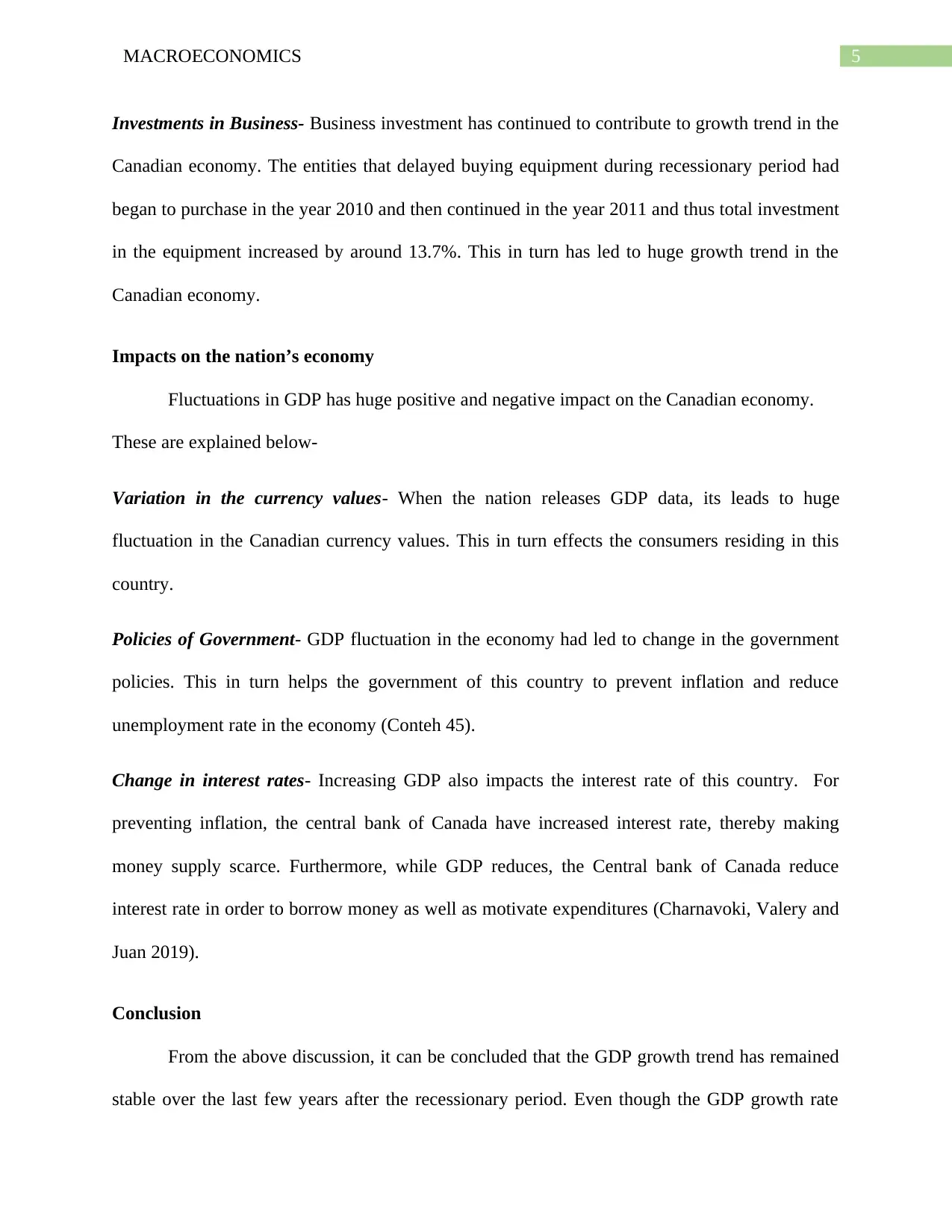
5MACROECONOMICS
Investments in Business- Business investment has continued to contribute to growth trend in the
Canadian economy. The entities that delayed buying equipment during recessionary period had
began to purchase in the year 2010 and then continued in the year 2011 and thus total investment
in the equipment increased by around 13.7%. This in turn has led to huge growth trend in the
Canadian economy.
Impacts on the nation’s economy
Fluctuations in GDP has huge positive and negative impact on the Canadian economy.
These are explained below-
Variation in the currency values- When the nation releases GDP data, its leads to huge
fluctuation in the Canadian currency values. This in turn effects the consumers residing in this
country.
Policies of Government- GDP fluctuation in the economy had led to change in the government
policies. This in turn helps the government of this country to prevent inflation and reduce
unemployment rate in the economy (Conteh 45).
Change in interest rates- Increasing GDP also impacts the interest rate of this country. For
preventing inflation, the central bank of Canada have increased interest rate, thereby making
money supply scarce. Furthermore, while GDP reduces, the Central bank of Canada reduce
interest rate in order to borrow money as well as motivate expenditures (Charnavoki, Valery and
Juan 2019).
Conclusion
From the above discussion, it can be concluded that the GDP growth trend has remained
stable over the last few years after the recessionary period. Even though the GDP growth rate
Investments in Business- Business investment has continued to contribute to growth trend in the
Canadian economy. The entities that delayed buying equipment during recessionary period had
began to purchase in the year 2010 and then continued in the year 2011 and thus total investment
in the equipment increased by around 13.7%. This in turn has led to huge growth trend in the
Canadian economy.
Impacts on the nation’s economy
Fluctuations in GDP has huge positive and negative impact on the Canadian economy.
These are explained below-
Variation in the currency values- When the nation releases GDP data, its leads to huge
fluctuation in the Canadian currency values. This in turn effects the consumers residing in this
country.
Policies of Government- GDP fluctuation in the economy had led to change in the government
policies. This in turn helps the government of this country to prevent inflation and reduce
unemployment rate in the economy (Conteh 45).
Change in interest rates- Increasing GDP also impacts the interest rate of this country. For
preventing inflation, the central bank of Canada have increased interest rate, thereby making
money supply scarce. Furthermore, while GDP reduces, the Central bank of Canada reduce
interest rate in order to borrow money as well as motivate expenditures (Charnavoki, Valery and
Juan 2019).
Conclusion
From the above discussion, it can be concluded that the GDP growth trend has remained
stable over the last few years after the recessionary period. Even though the GDP growth rate
⊘ This is a preview!⊘
Do you want full access?
Subscribe today to unlock all pages.

Trusted by 1+ million students worldwide
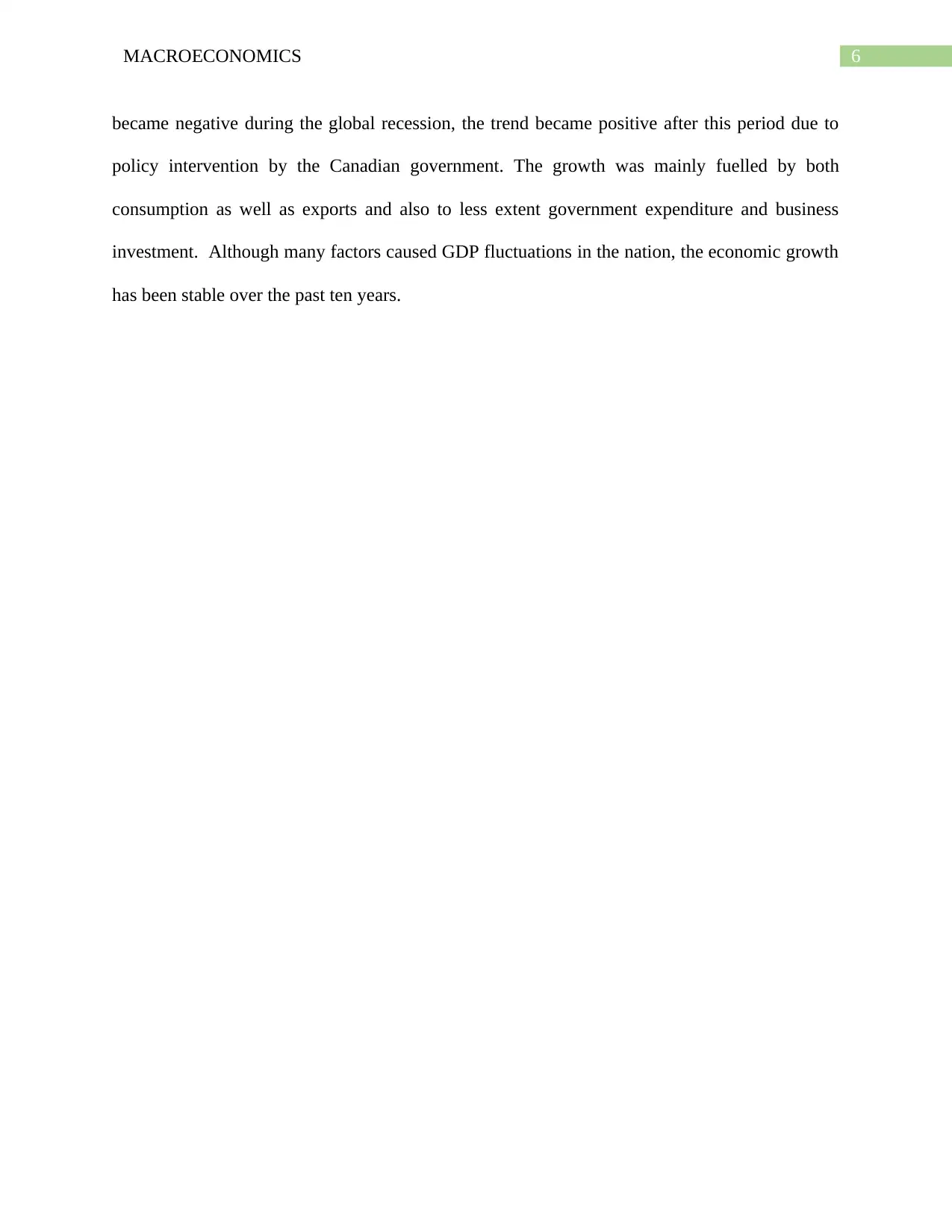
6MACROECONOMICS
became negative during the global recession, the trend became positive after this period due to
policy intervention by the Canadian government. The growth was mainly fuelled by both
consumption as well as exports and also to less extent government expenditure and business
investment. Although many factors caused GDP fluctuations in the nation, the economic growth
has been stable over the past ten years.
became negative during the global recession, the trend became positive after this period due to
policy intervention by the Canadian government. The growth was mainly fuelled by both
consumption as well as exports and also to less extent government expenditure and business
investment. Although many factors caused GDP fluctuations in the nation, the economic growth
has been stable over the past ten years.
Paraphrase This Document
Need a fresh take? Get an instant paraphrase of this document with our AI Paraphraser
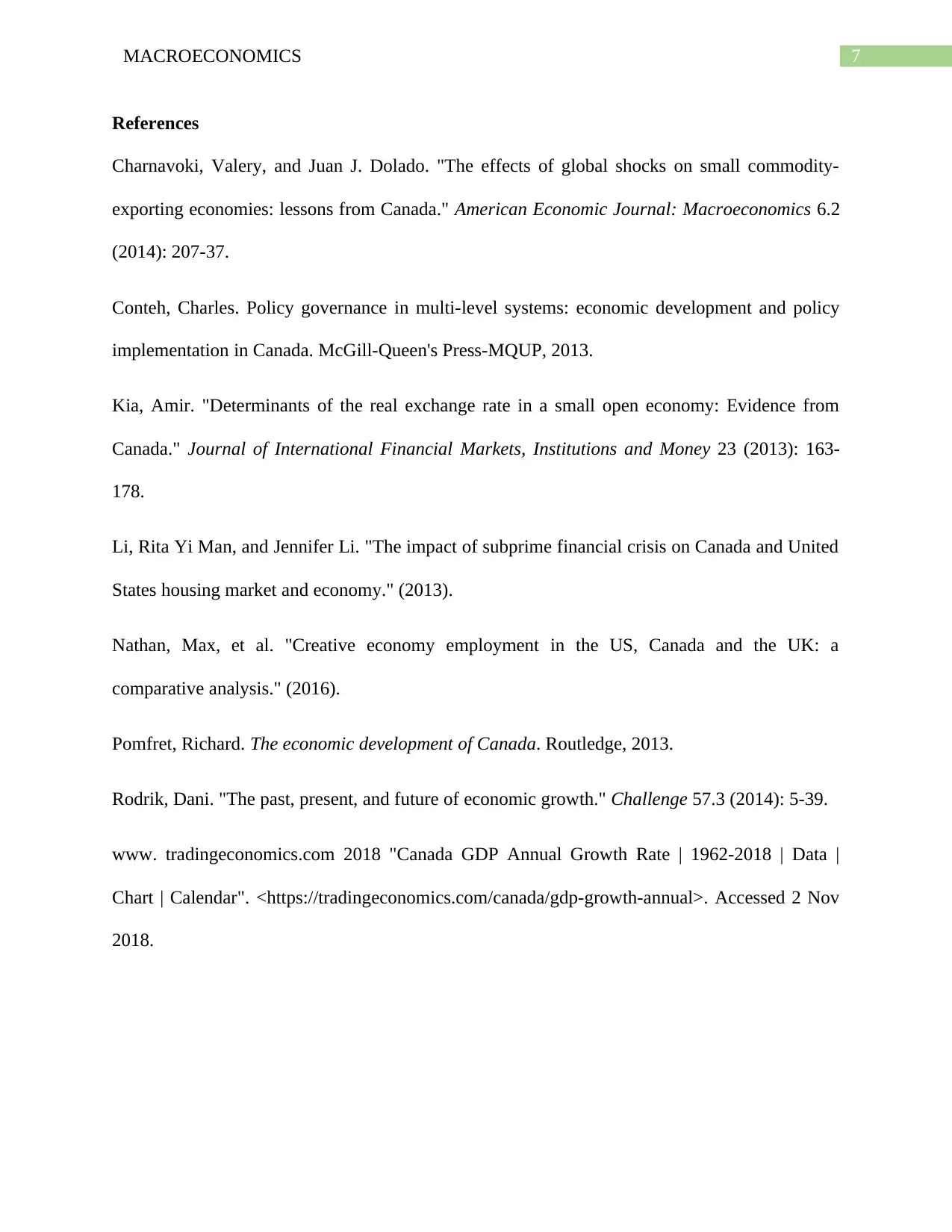
7MACROECONOMICS
References
Charnavoki, Valery, and Juan J. Dolado. "The effects of global shocks on small commodity-
exporting economies: lessons from Canada." American Economic Journal: Macroeconomics 6.2
(2014): 207-37.
Conteh, Charles. Policy governance in multi-level systems: economic development and policy
implementation in Canada. McGill-Queen's Press-MQUP, 2013.
Kia, Amir. "Determinants of the real exchange rate in a small open economy: Evidence from
Canada." Journal of International Financial Markets, Institutions and Money 23 (2013): 163-
178.
Li, Rita Yi Man, and Jennifer Li. "The impact of subprime financial crisis on Canada and United
States housing market and economy." (2013).
Nathan, Max, et al. "Creative economy employment in the US, Canada and the UK: a
comparative analysis." (2016).
Pomfret, Richard. The economic development of Canada. Routledge, 2013.
Rodrik, Dani. "The past, present, and future of economic growth." Challenge 57.3 (2014): 5-39.
www. tradingeconomics.com 2018 "Canada GDP Annual Growth Rate | 1962-2018 | Data |
Chart | Calendar". <https://tradingeconomics.com/canada/gdp-growth-annual>. Accessed 2 Nov
2018.
References
Charnavoki, Valery, and Juan J. Dolado. "The effects of global shocks on small commodity-
exporting economies: lessons from Canada." American Economic Journal: Macroeconomics 6.2
(2014): 207-37.
Conteh, Charles. Policy governance in multi-level systems: economic development and policy
implementation in Canada. McGill-Queen's Press-MQUP, 2013.
Kia, Amir. "Determinants of the real exchange rate in a small open economy: Evidence from
Canada." Journal of International Financial Markets, Institutions and Money 23 (2013): 163-
178.
Li, Rita Yi Man, and Jennifer Li. "The impact of subprime financial crisis on Canada and United
States housing market and economy." (2013).
Nathan, Max, et al. "Creative economy employment in the US, Canada and the UK: a
comparative analysis." (2016).
Pomfret, Richard. The economic development of Canada. Routledge, 2013.
Rodrik, Dani. "The past, present, and future of economic growth." Challenge 57.3 (2014): 5-39.
www. tradingeconomics.com 2018 "Canada GDP Annual Growth Rate | 1962-2018 | Data |
Chart | Calendar". <https://tradingeconomics.com/canada/gdp-growth-annual>. Accessed 2 Nov
2018.
1 out of 8
Related Documents
Your All-in-One AI-Powered Toolkit for Academic Success.
+13062052269
info@desklib.com
Available 24*7 on WhatsApp / Email
![[object Object]](/_next/static/media/star-bottom.7253800d.svg)
Unlock your academic potential
Copyright © 2020–2025 A2Z Services. All Rights Reserved. Developed and managed by ZUCOL.





